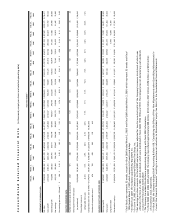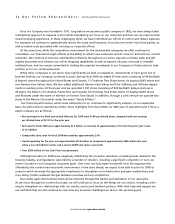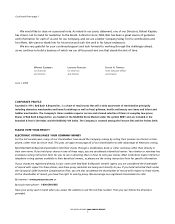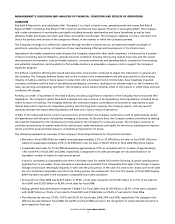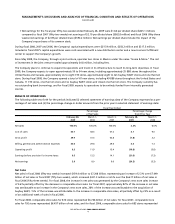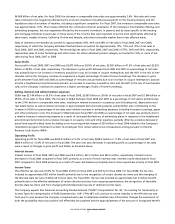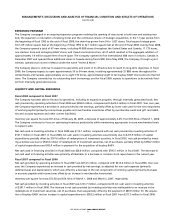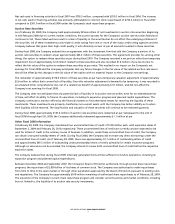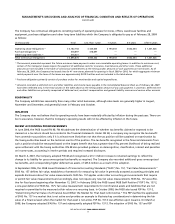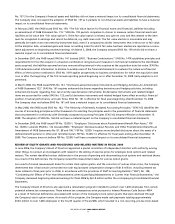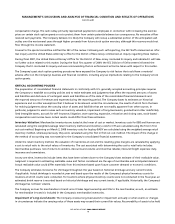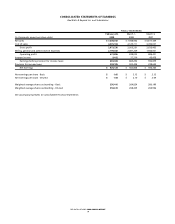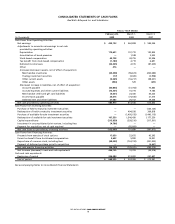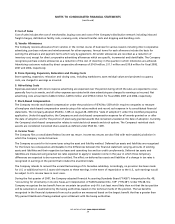Bed, Bath and Beyond 2008 Annual Report Download - page 12
Download and view the complete annual report
Please find page 12 of the 2008 Bed, Bath and Beyond annual report below. You can navigate through the pages in the report by either clicking on the pages listed below, or by using the keyword search tool below to find specific information within the annual report.
compensation charge. The cash outlay primarily represented payments to employees in connection with increasing the exercise
prices on certain stock option grants so as to protect them from certain potential adverse tax consequences. No executive officer
received such payments. The Company believes it is likely the Company will recoup a substantial portion of the anticipated cash
outlay over the next several years through higher proceeds from future stock option exercises, although this recovery would not
flow through the income statement.
Counsel to the special committee notified the SEC of the review. Following such self-reporting, the SEC Staff commenced an infor-
mal inquiry and the United States Attorney’s office for the District of New Jersey commenced an inquiry regarding these matters.
During fiscal 2007, the United States Attorney’s Office for the District of New Jersey concluded its inquiry and indicated it will take
no further action related to this matter. During the fiscal first quarter of 2009, the SEC Division of Enforcement informed the
Company that it concluded its inquiry and was recommending that no enforcement action be taken with respect to this matter.
The Company’s past stock option granting procedures have exposed the Company to risk factors that could have a material
adverse affect on the Company’s business and financial condition, including any tax implications relating to the Company’s stock
option grants.
CRITICAL ACCOUNTING POLICIES
The preparation of consolidated financial statements in conformity with U.S. generally accepted accounting principles requires
the Company to establish accounting policies and to make estimates and judgments that affect the reported amounts of assets
and liabilities and disclosure of contingent assets and liabilities as of the date of the consolidated financial statements and
the reported amounts of revenues and expenses during the reporting period. The Company bases its estimates on historical
experience and on other assumptions that it believes to be relevant under the circumstances, the results of which formthe basis
for making judgments about the carrying value of assets and liabilities that arenot readily apparent from other sources. In
particular, judgment is used in areas such as inventory valuation, impairment of long-lived assets, goodwill and other indefinitely
lived intangible assets, accruals for self insurance, litigation, store opening, expansion, relocation and closing costs, stock-based
compensation and income taxes. Actual results could differ from these estimates.
Inventory Valuation: Merchandise inventories are stated at the lower of cost or market. Inventory costs for BBB and Harmon are
calculated using the weighted average retail inventory method and inventory costs for CTS are calculated using the first in first
out cost method. Beginning on March 2, 2008 inventorycosts for buybuy BABY are calculated using the weighted average retail
inventorymethod, whereas previously, they were calculated using the first in first out cost method. The impact of the change in
the method of accounting was not material to the Company’sconsolidated financial statements.
Under the retail inventory method, the valuation of inventories at cost and the resulting gross margins are calculated by applying
acost to retail ratio to the retail values of inventories. The cost associated with determining the cost to retail ratio includes:
merchandise purchases, net of returns to vendors, discounts and volume and incentive rebates; inbound freight expenses; duty,
insurance and commissions.
At any one time, inventories include items that have been written down to the Company’s best estimate of their realizable value.
Judgment is required in estimating realizable value and factors considered arethe age of merchandise and anticipated demand.
Actual realizable value could differ materially from this estimate based upon future customer demand or economic conditions.
The Company estimates its reserve for shrinkage throughout the year based on historical shrinkage and any current trends,
if applicable. Actual shrinkage is recorded at year end based upon the results of the Company’sphysical inventorycounts for
locations at which counts were conducted. For locations where physical inventory counts were not conducted in the fiscal year, an
estimated shrink reserve is recorded based on historical shrinkage and any current trends, if applicable. Historically, the Company’s
shrinkage has not been volatile.
The Company accrues for merchandise in transit once it takes legal ownership and title to the merchandise; as such, an estimate
for merchandise in transit is included in the Company’s merchandise inventories.
Impairment of Long-Lived Assets: The Company reviews long-lived assets for impairment annually or when events or changes
in circumstances indicate the carrying value of these assets may exceed their current fair values. Recoverability of assets to be held
MANAGEMENT’S DISCUSSION AND ANALYSIS OF FINANCIAL CONDITION AND RESULTS OF OPERATIONS
(continued)
BED BATH & BEYOND 2008 ANNUAL REPORT
10


